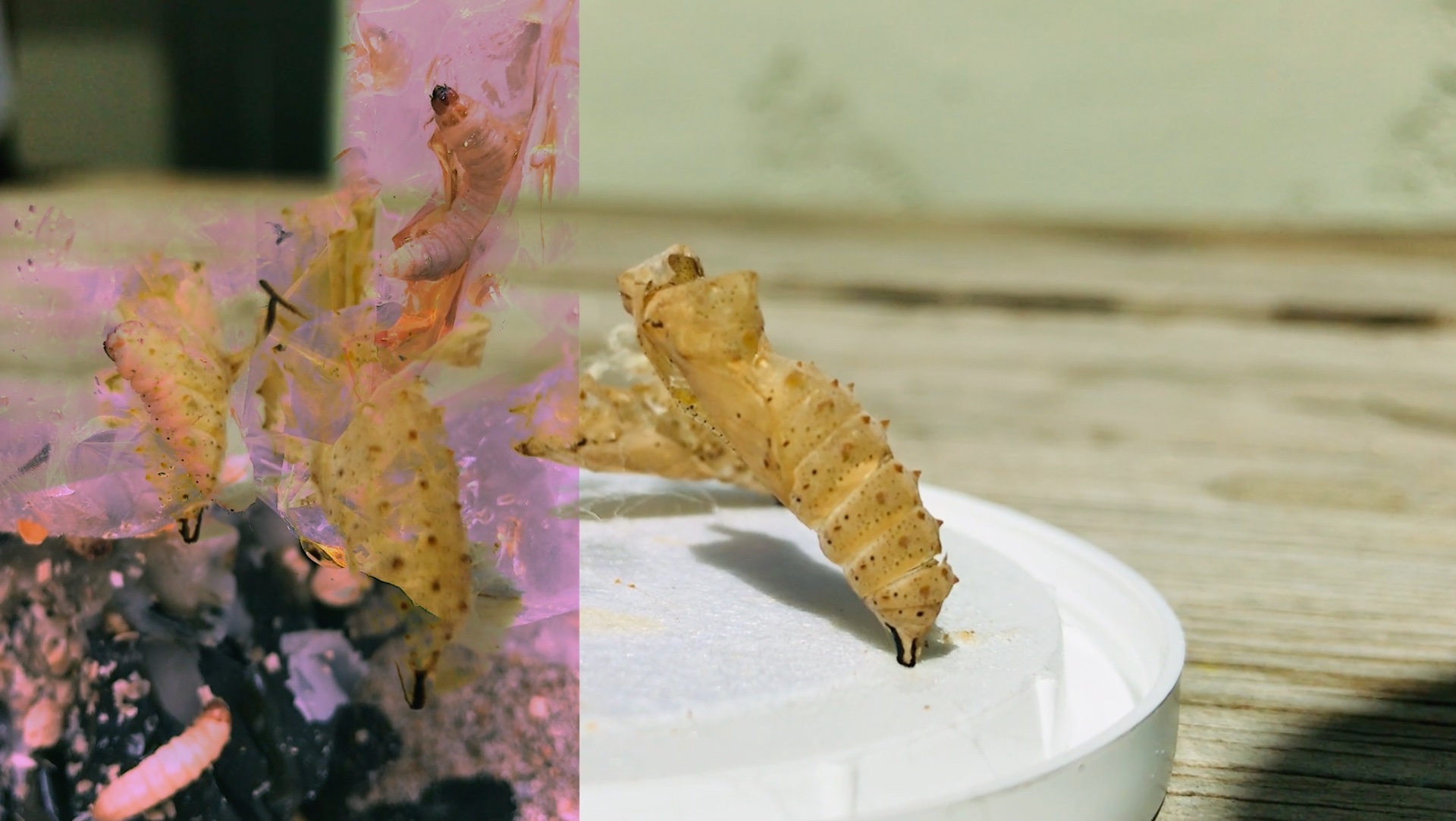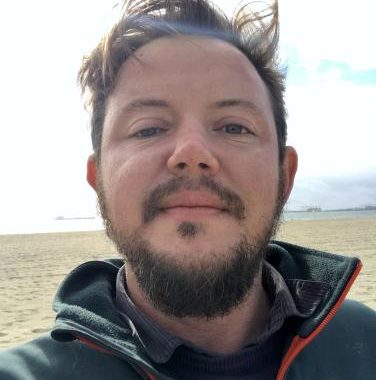
Ashton S. Phillips is an interdisciplinary artist based in Los Angeles, working with the earth, water, pollution, and more-than-human agents of (dis)repair as primary materials and collaborators. He is interested in the transness of material, the plasticity of bodies (human and nonhuman), and the promise of queer/trans ecological praxis, including interspecies collaboration, experimental “play,” and speculative (un)making, as pathways for making meaning, building resiliency, and generating new forms of being in the Capitalocene. Recent solo shows and public art commissions include Worm Hole at TSA, LA; Womb/Tomb/BooM at MICA; Feast + Famine at Cerritos College; and Sky Burial at Debs Park.
Artist Location: Long Beach, CA
Social Media:
PARTICIPATION
Compost Touch
For Charivari, I propose a new interactive sound installation and participatory performance composed of a series of cubes and other sonified objects projecting a symphony of sounds derived from the more-than- human ecosystem of plastic metamorphosis, contamination and repair at the heart of my practice. Wherever possible, these cubes will house living agents of (dis)repair (mealworms, wax worms, darkling beetles, red wrigglers, black soldier fly larvae, isopods, snails) whose sound will be amplified live. Additional cubes and vessels will hold related materials like mud, water, asphalt rubble, and plastic trash which will remain silent unless touched by a participant.
The vessels will be propped on pillars and slabs of raw polystyrene foam that has been partially consumed by my colony of mealworms and partially decomposed driftwood found at plastic-polluted beaches. Participants will be invited to also rest their bodies on these slabs and trunks of decomposing plastic and wood.
Gallery show, May 13 – June 17:
Surrender
I had to become purple in order to see and hear the purple things.
I had to give my body to their mouths, before I could speak.
I had to touch the unstable ground, lay myself down on it, and become sediment, before I could stand.
Surrender is an interactive, multimedia installation of plastic bodies, including partially consumed styrofoam, desiccated wildflowers, mealworm sheds, and colored light encased in a translucent violet skin. Participants are invited to activate this work by becoming a plastic body, in a sense. Participants may climb onto this vinyl form and feel the sensation of their body being held by a bed of partially transformed plastic. They can surrender themselves, for a moment, to this field of metamorphosis-friendly purple light and allow themselves to be covered in a bath of shapeshifting sound. Contact microphones embedded in the sculpture allow participants to contribute to this experimental, interspecies composition. As each person settles into the sculpture, the embedded microphones transmit the live sound of styrofoam shifting and settling under the participants mass to the resonating plane overhead.

Photo by Jordan Rodriguez
Becoming Insect
Installation:
Emerging out of a pandemic-era investigation into the capacity of mealworms and other metamorphosing insects to consume, metabolize, and transform petroleum-based plastics into energy for their bodies and biodegradable hydrocarbons, “becoming insect” will combine an installation of partially consumed styrofoam and found offertory materials, like wildflowers, carrots, and fruit, with a “worms-eye” and “worms-ear” projection of visual and auditory information created by the colony’s composting activity. Multiple microphones will be placed in the body of the installation to record the complex sounds of the colony, as they consume and transform the styrofoam and other materials. This sound will be amplified using a portable amplification system. Additional tracks will be recorded and mixed with the live worm sounds, including sounds associated with the source of styrofoam, like the sounds of a human unwrapping an Amazon package containing styrofoam, a human eating takeout food served in a styrofoam container, a soda fountain filling up a styrofoam cup, and a container ship’s low wail as it comes into port carrying goods protected with styrofoam. A microscopic camera will also be embedded into the colony, with a live feed projected onto an adjacent wall (if available), inviting viewers into a worm’s-eye view of this posthuman ecology of metamorphosis and repair.
VBODOBV | dEvolution: Au Naturel
Hunger

Proposed work as accepted for soundpedro 2021:
Hunger (Engine)
I propose a sound-oriented presentation of Hunger – an experimental project exploring the life cycle of the greater wax “worm” (galleria mellonella) and its ecologically unique ability to biodegrade microplastic, as a poetic, sculptural and sonic performance. Hunger will include a cycle of 4 Phases or Acts, each of which will be recorded with sound and video equipment.
Phase 1 will consist of harvesting invisible microplastics from local waterways, using an electrostatic filtration system, a shovel, a broom, and a little physical effort. In Phase 2, I will cast the harvested microplastic debris into simple sculptural forms or bodies using beeswax and honey as a binder. In Phase 3, I will construct a vivarium, using recycled windows, with one chamber for the larval and cocooning stages of galleria mellonella and another chamber for the reproductive moth stage. In Phase 4, I will place the microplastic objects into the larval chamber as food. The larvae will consume the plastic and convert the fuel locked within it into energy for metamorphosis, flight, and reproduction.
Option 1: A live installation of the vivarium in a low-light space, illuminated by worm-friendly red light with a projected composition of sounds collected during the development of Hunger (e.g., the sounds of sifting sand as microplastics are extracted; the sounds of larvae eating the microplastics, sounds gathered near waterways, including the Los Angeles River and the Long Beach harbor).
Hunger (Objects)
Option 2: An indoor or outdoor exhibition of partially-consumed, cast microplastic and wax objects from the Hunger cycle, projecting a freeform composition of sounds gathered in the construction of this object, including the sounds from the harvesting of the microplastics and sounds of the galleria mellonella consuming it.
Option 3: A poetic video and sound composition that could be shared virtually or projected outdoors, composed using imagery and audio gathered in the process of constructing the vivarium, including a worm’s-eye-view video.
Virtual Breakout During the Outbreak June 6th Livestream
Virtual BreakOut During the OutBreak Videos [VBODOBV] II
(im)Material Remains

Proposed work as accepted for soundpedro 2020:
Grounding Place (San Pedro)
I would recreate a version of the concept proposed above using site-specific materials. For this version of the work, I would spend time in and around Angels Gate, including the cliffside and rocky shore along Abalone Cove gathering both organic and inorganic materials. Materials would likely include accumulations of the rounded rocks along San Pedro’s coastline, which create a complex tinkling sound when walked upon; chunks of asphalt and dirt collected from local construction sites; landscaping debris, including downed palm fronds and tree limbs; and discarded metal (e.g., downed signage and posts). I would then “play” and record these materials, using hand-held directional microphones, and collage these improvised percussive performances together. As in the first audio collage, my goal in layering these found/material-driven sounds together would be to create a complex web of interacting audio textures that help locate the listener in their body and larger material environment.
A sculptural installation would also be created for the event using the “played” materials. As with the first version, I hope that using sound and material together in this way will facilitate a kind of multi-sensory “grounding” experience for the audience that opens up new perspectives on the incredible complexity of our immediate physical environment, including the most mundane objects we often devalue as “waste.”
